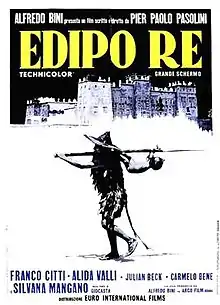Oedipus Rex (1967 film)
Oedipus Rex (Edipo re) is a 1967 Italian film directed by Pier Paolo Pasolini.[1] Pasolini adapted the screenplay from the Greek tragedy Oedipus Rex written by Sophocles in 428 BC. The film was mainly shot in Morocco.
| Oedipus Rex | |
|---|---|
 | |
| Directed by | Pier Paolo Pasolini |
| Produced by | Alfredo Bini |
| Screenplay by | Pier Paolo Pasolini |
| Based on | Oedipus Rex by Sophocles |
| Starring |
|
| Cinematography | Giuseppe Ruzzolini |
| Edited by | Nino Baragli |
Production company | Arco Film |
| Distributed by | Euro International Films |
Release date |
|
Running time | 104 minutes |
| Country | Italy |
| Language | Italian |
Plot
A son is born to a young couple in pre-war Italy. The father, motivated by jealousy, takes the baby into the desert to be abandoned, at which point the film's setting changes to the ancient world. The child is rescued, named Oedipus by King Polybus (Ahmed Belhachmi) and Queen Merope (Alida Valli) of Corinth and raised as their own son. When Oedipus (Franco Citti) learns of a prophecy foretelling that he will kill his father and marry his mother, he leaves Corinth believing that Polybus and Merope are his true parents.
On the road to Thebes, Oedipus meets Laius (Luciano Bartoli), his biological father, and kills him after an argument. Later Oedipus solves the riddle of the Sphinx. For freeing the kingdom of Thebes from the Sphinx's curse he is rewarded with kingship and marriage to Queen Jocasta (Silvana Mangano), who is his biological mother. When they discover what they have done, fulfilling the prophecy, Oedipus blinds himself and Jocasta commits suicide.
Awards
Italian National Syndicate of Film Journalist
Won Silver Ribbon
Alfredo Bini for Best Producer and Luigi Scaccianoce for Best Production Design
1968
Kinema Junpo Awards
Won Best Foreign Language Film
1970
Venice Film Festival
Nominated for Golden Lion
[2]
1967
References
- "The New York Times". Archived from the original on 2013-07-21. Retrieved 2017-02-11.
- Oedipus Rex at Venice Film Festival's website (in Italian)